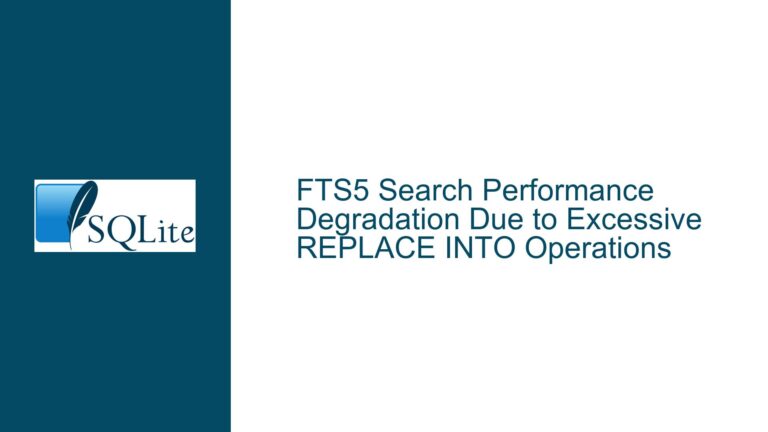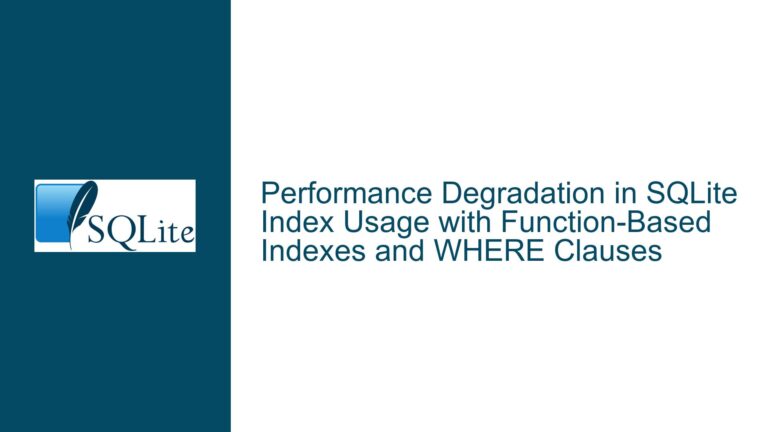Optimizing SQLite Performance on Mobile: PSOW and LFS Considerations
Understanding SQLITE_POWERSAFE_OVERWRITE and SQLITE_DISABLE_LFS for Mobile Platforms
The SQLITE_POWERSAFE_OVERWRITE (PSOW) and SQLITE_DISABLE_LFS compilation flags are two powerful tools for optimizing SQLite performance, particularly on mobile platforms like Android and iOS. However, their usage requires a deep understanding of their implications, especially in the context of power safety and file system behavior. SQLITE_POWERSAFE_OVERWRITE ensures that writes are atomic even in the event of a power failure, while SQLITE_DISABLE_LFS disables Large File Support (LFS), which can improve performance by avoiding certain file system overheads. Both flags can significantly impact write performance, but their safety and suitability for mobile platforms must be carefully evaluated.
Mobile platforms often use SSDs (Solid State Drives) or flash-based storage, which have different characteristics compared to traditional hard drives. SSDs typically have faster sector writes and better wear leveling, which might make them more resilient to power failures. However, the behavior of the file system and the underlying hardware during power loss or application crashes is not always predictable. Enabling PSOW can provide additional safety guarantees, but it may come at the cost of reduced write performance. Similarly, disabling LFS can improve performance but may introduce limitations on file sizes or compatibility issues with certain file systems.
The core issue revolves around balancing performance optimization with data integrity and safety. Developers must consider the trade-offs between enabling these flags and the potential risks of data corruption or loss during power failures or crashes. This requires a thorough understanding of the file system behavior, the hardware characteristics, and the specific requirements of the application.
Potential Risks and Misconceptions About PSOW and LFS on Mobile Platforms
One of the primary misconceptions is that SSDs inherently provide power safety due to their faster write speeds and wear leveling mechanisms. While SSDs are generally more resilient than traditional hard drives, they are not immune to data corruption during power failures. The file system and the SQLite database engine must still ensure that writes are atomic and durable, especially in scenarios where the application crashes or the device loses power unexpectedly. This is where SQLITE_POWERSAFE_OVERWRITE comes into play. Enabling PSOW ensures that writes are performed in a way that guarantees atomicity, even if the power is lost mid-write. However, this safety mechanism can introduce additional overhead, potentially reducing write performance.
Another misconception is that disabling LFS will always result in performance improvements. While LFS introduces some overhead by supporting files larger than 2GB, it also provides compatibility with modern file systems and ensures that SQLite can handle large databases efficiently. Disabling LFS might improve performance in certain scenarios, but it can also lead to issues if the database grows beyond the supported file size limits. Additionally, some file systems may not handle large files properly without LFS, leading to unexpected behavior or errors.
The risks associated with enabling or disabling these flags depend on the specific use case and the environment in which the application is running. For example, an application that frequently performs small writes might benefit more from enabling PSOW, while an application that handles large datasets might prioritize disabling LFS. However, these decisions must be made with a clear understanding of the potential trade-offs and risks.
Step-by-Step Guide to Evaluating and Implementing PSOW and LFS for Mobile SQLite Optimization
To determine whether to enable SQLITE_POWERSAFE_OVERWRITE or disable SQLITE_DISABLE_LFS, developers should follow a systematic approach that includes testing, benchmarking, and risk assessment. The first step is to evaluate the specific requirements of the application, including the expected database size, the frequency and size of write operations, and the potential impact of data corruption or loss. This evaluation should be based on real-world usage scenarios and should take into account the behavior of the file system and hardware on the target platforms.
Next, developers should conduct performance benchmarks to measure the impact of enabling PSOW and disabling LFS. These benchmarks should include a variety of write operations, ranging from small, frequent writes to large, bulk writes. The results should be compared against a baseline configuration to determine the performance gains or losses associated with each flag. It is important to conduct these tests under realistic conditions, including simulated power failures and application crashes, to assess the safety and reliability of the configuration.
Once the benchmarks are complete, developers should analyze the results and weigh the performance improvements against the potential risks. If enabling PSOW provides significant safety benefits without a substantial performance penalty, it may be worth enabling. Similarly, if disabling LFS results in noticeable performance gains without introducing compatibility issues or file size limitations, it may be a viable option. However, if the risks outweigh the benefits, developers should consider alternative optimization strategies, such as tuning the SQLite pragmas or optimizing the schema design.
Finally, developers should document their findings and decisions, including the rationale for enabling or disabling each flag and the results of the benchmarks. This documentation should be shared with the team and reviewed periodically to ensure that the configuration remains appropriate as the application evolves. By following this systematic approach, developers can make informed decisions about optimizing SQLite performance on mobile platforms while minimizing the risks of data corruption or loss.
In conclusion, optimizing SQLite performance on mobile platforms requires a careful balance between performance and safety. The SQLITE_POWERSAFE_OVERWRITE and SQLITE_DISABLE_LFS flags offer powerful tools for improving write performance, but their usage must be evaluated in the context of the specific application and environment. By understanding the potential risks and misconceptions, conducting thorough benchmarks, and following a systematic approach, developers can make informed decisions that enhance performance without compromising data integrity.






